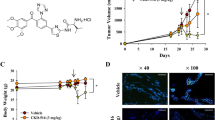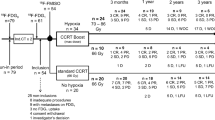Abstract
Objective
To investigate the clinical effects and adverse effects of weekly recombinant human endostatin (RHES) as a hypoxic tumour cell radiosensitiser combined with radiotherapy in the treatment of non-small-cell lung cancer (NSCLC).
Methods
Fifty hypoxia-positive cases of pathology-diagnosed NSCLC (stage I–III) were randomly divided into a RHES+radiotherapy group (25 cases) and a radiotherapy alone group (25 cases). Intensity-modulated radiotherapy (IMRT) with a total dose of 60 Gy/30F/6W was adopted in the two groups. Target area included primary foci and metastatic lymph nodes. In the RHES+radiotherapy group, RHES (15 mg/day) was intravenously given during the first week. The therapeutic effects and adverse reactions were evaluated after treatment.
Results
In the RHES+radiotherapy and radiotherapy alone groups, the total effective rates (CR+PR) were 80% and 44% (χ2=6.87, p=0.009), respectively. The one-year and two-year local control rates were (78.9±8.4)% and (68.1±7.8)% (p=0.027), and (63.6±7.2)% and (43.4±5.7)% (p=0.022), respectively. The median progression-free survival was (21.1±0.97) and (16.5±0.95) months, respectively. The one-year and two-year overall survival rates were (83.3±7.2)% and (76.6±9.3)% (p=0.247), and (46.3±2.4)% and (37.6±9.1)% (p=0.218), respectively.
Conclusion
RHES combined with radiotherapy within the first week has better short-term therapeutic effects and local control rate, and no severe adverse reactions in treatment of NSCLC. However, it failed to significantly improve the one-year and two-year overall survival rates.
Similar content being viewed by others
References
Ling CH, Ji C, Chen YB et al (2004) Combined effects of endostatin gene transfer and ionizing radiation on lung adenocarcinoma model of A549 cells. Chin J Tuberc Respir Dis 27:683–686
Luo X, Andres ML, Timiryasova TM et al (2005) Radiation enhanced endostatin gene expression and effects of combination treatment. Technol Cancer Res Treat 4:193–202
Huang G, Chen L (2010) Recombinant human endostatin improves anti-tumor efficacy of paclitaxel by normalizing tumor vasculature in Lewis lung carcinoma. J Cancer Res Clin Oncol 136:1201–1211
Carmeliet P, Jain PK (2000) Angiogenesis in cancer and other disease. Nature 407:249–257
Dachs GU, Tozer GM (2000) Hypoxia modulated gene expression: angiogenesis, metastasis and therapeutic exploitation. Eur J Cancer 36:1649–1660
Haugland HK, Vukovic V, Pintilie M et al (2002) Expression of hypoxia-inducible factor 1α in cervical carcinomas correlation with tumor oxygenation. Int J Radiation Oncol Biol Phys 53:854–861
Jiang X-d, Dai P, Song D-a et al (2011) The correlation of 99mTc-HL91 hypoxia imaging and expression of HIF-1α. Modern Oncol 19:43–45
Jain RK (2005) Normalization of tumor vasculature: an emerging concept in antiangiogenic therapy. Science 307:58–62
Winkler F, Kozin SV, Tong RT et al (2004) Kinetics of vascular normalization by VEGFR2 blockade governs brain tumor response to radiation: role of oxygenation. Angiopoietin-1, and matrix metalloproteinases. Cancer Cell 6:553–563
Jiang X-d, Dai P, Wu J et al (2011) The inhibitory effects of radiotherapy combined with weekly dosage endostatin on the growth of transplanted human lung cancer cell line A549 in nude mice. Lung Cancer 72:165–171
Author information
Authors and Affiliations
Corresponding author
Additional information
These authors contributed equally to this work.
Rights and permissions
About this article
Cite this article
Jiang, XD., Qiao, Y., Dai, P. et al. Preliminary clinical study of weekly recombinant human endostatin as a hypoxic tumour cell radiosensitiser combined with radiotherapy in the treatment of NSCLC. Clin Transl Oncol 14, 465–470 (2012). https://doi.org/10.1007/s12094-012-0825-z
Received:
Accepted:
Issue Date:
DOI: https://doi.org/10.1007/s12094-012-0825-z




